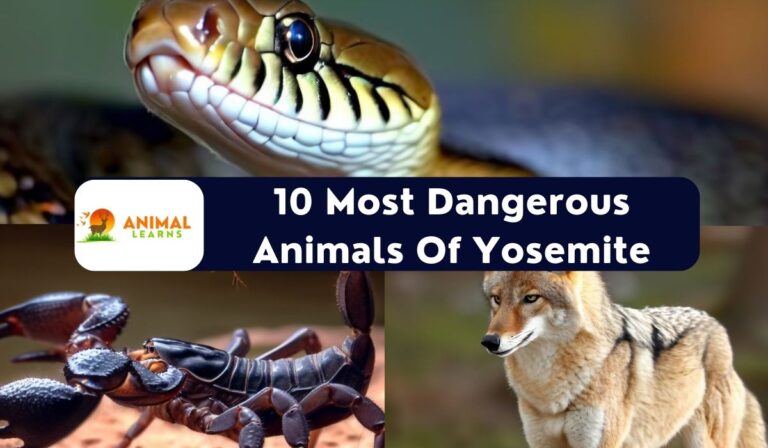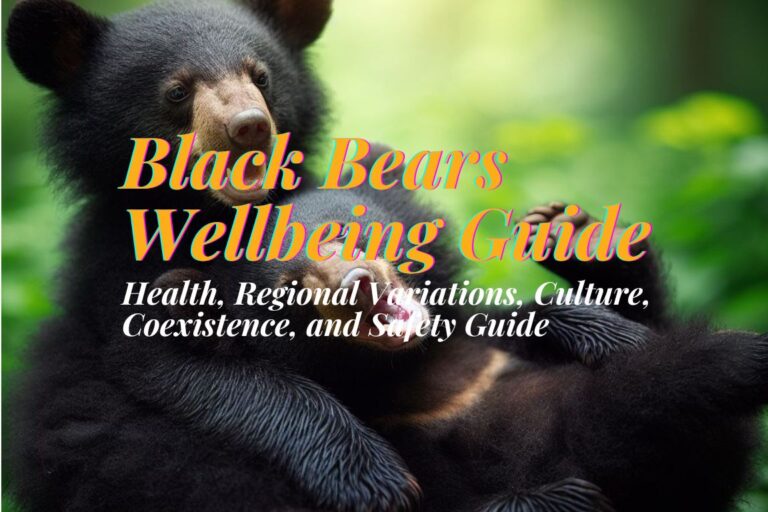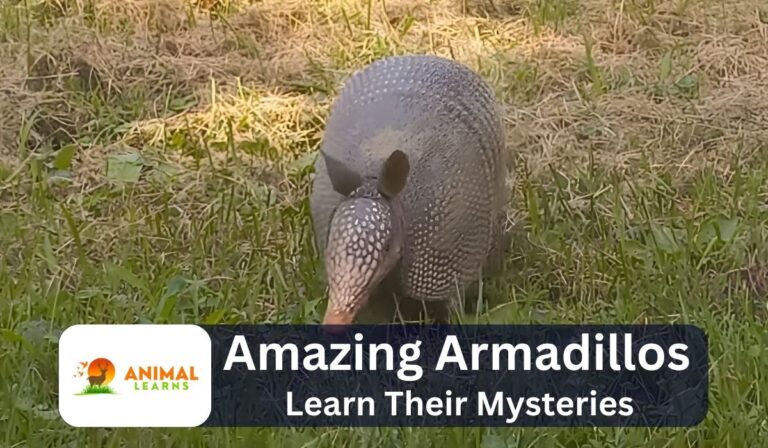Cheetahs: The Amazing Fastest Animals on Earth

Cheetahs are among the most fascinating and endangered animals in the world. They are known for their incredible speed, agility, and grace. In this article, we will explore everything you need to know about cheetahs, from their natural habitat and diet to their conservation efforts and records. Let’s get started!
The Need for Speed: Cheetahs in Action
Contents
- 1 The Need for Speed: Cheetahs in Action
- 2 The appearance
- 3 Cheetah Characteristics
- 4 Behavior and lifestyle
- 5 Predators
- 6 Natural Habitat
- 7 A Gourmet Diet: What Do Cheetahs Eat?
- 8 Cheetahs Around the World
- 9 Cheetahs and Other Creatures
- 10 Survival of the Fastest: Cheetah Adaptations
- 11 Interesting Facts
- 12 Mating
- 13 Cheetahs vs. the World: A Look into Their Lives
- 14 FAQs
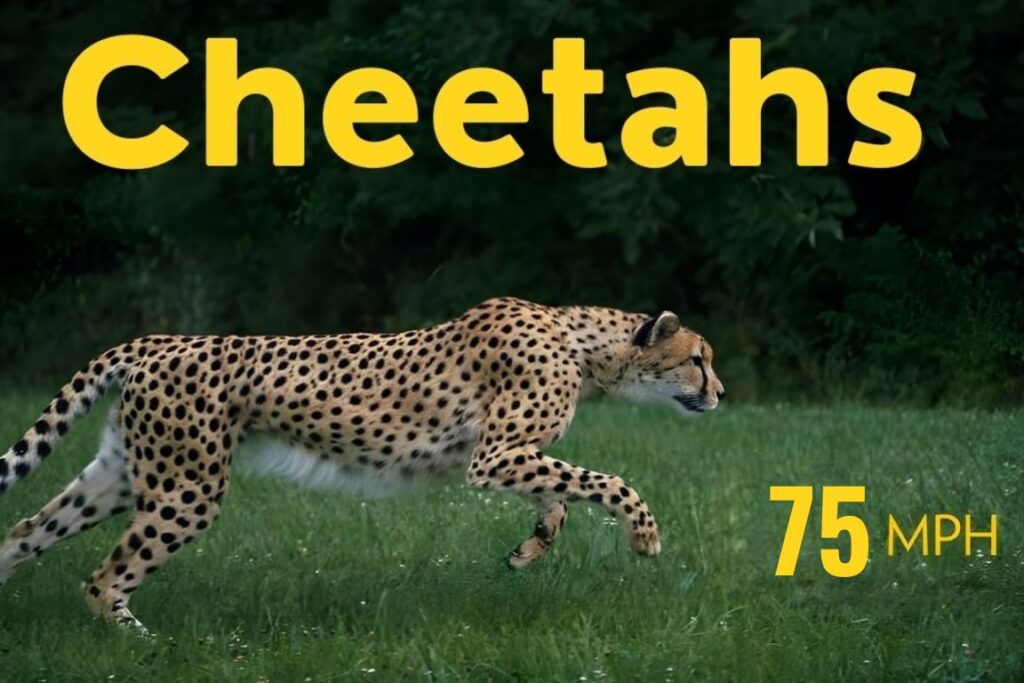
They are the fastest land animals on Earth, they are known for their remarkable speed and unique characteristics. These magnificent creatures can be found in various regions, including the grasslands of Africa, their primary habitat.
One of the main reasons why people are drawn to cheetah is their astonishing speed. Cheetah is the fastest land animals on earth, capable of reaching speeds of up to 120 km/h (75 mph) in short bursts.
They can accelerate from 0 to 96 km/h (60 mph) in just three seconds, faster than most sports cars. They can also change direction quickly and maintain balance with their long tails.
With a specialized diet primarily consisting of small to medium-sized ungulates like gazelles, they are finely adapted for sprinting and catching their prey. Their sleek bodies, long legs, and distinctive tear marks on their faces contribute to their striking appearance.
The appearance

They are stunning animals that have a unique look. They have slim and long bodies with yellow-gold fur that has small black dots all over it. These dots also cover their face and neck, where they form black lines that look like tears running from their eyes to their noses.
This special feature helps them see better in the bright sun and focus on their prey. Their body is made for speed, with big nostrils for breathing fast and sharp claws that help them run faster.
Unlike other big cats, cheetahs cannot roar; instead, they make different sounds, such as purring, growling, and hissing, to talk to each other. Their appearance shows how they are the fastest animals on land.
Cheetah Characteristics
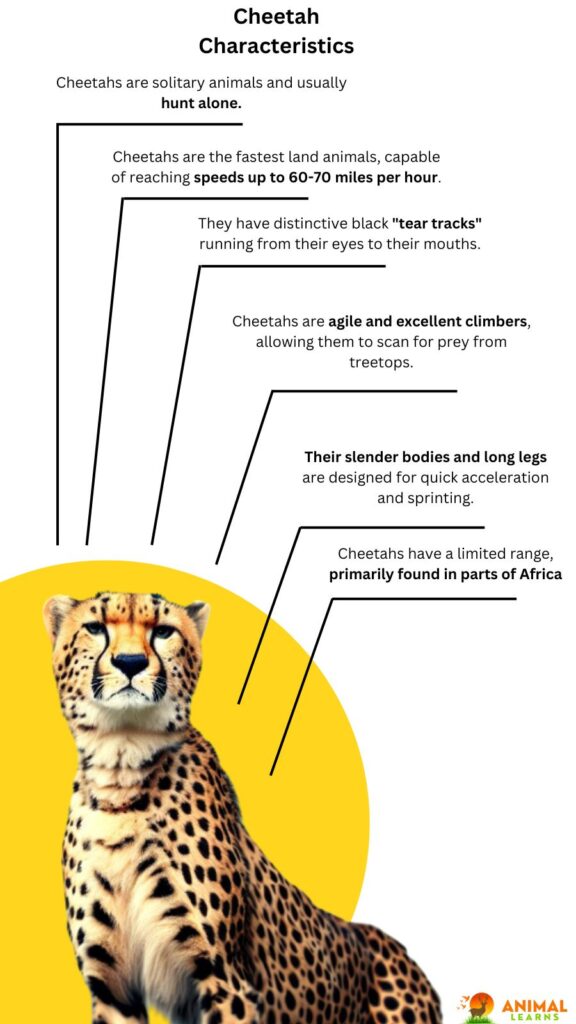
- They are the fastest land animals, capable of reaching speeds up to 60-70 miles per hour.
- They have distinctive black “tear tracks” running from their eyes to their mouths.
- They are agile and excellent climbers, allowing them to scan for prey from treetops.
- Their slender bodies and long legs are designed for quick acceleration and sprinting.
- They have a limited range, primarily found in parts of Africa.
Behavior and lifestyle
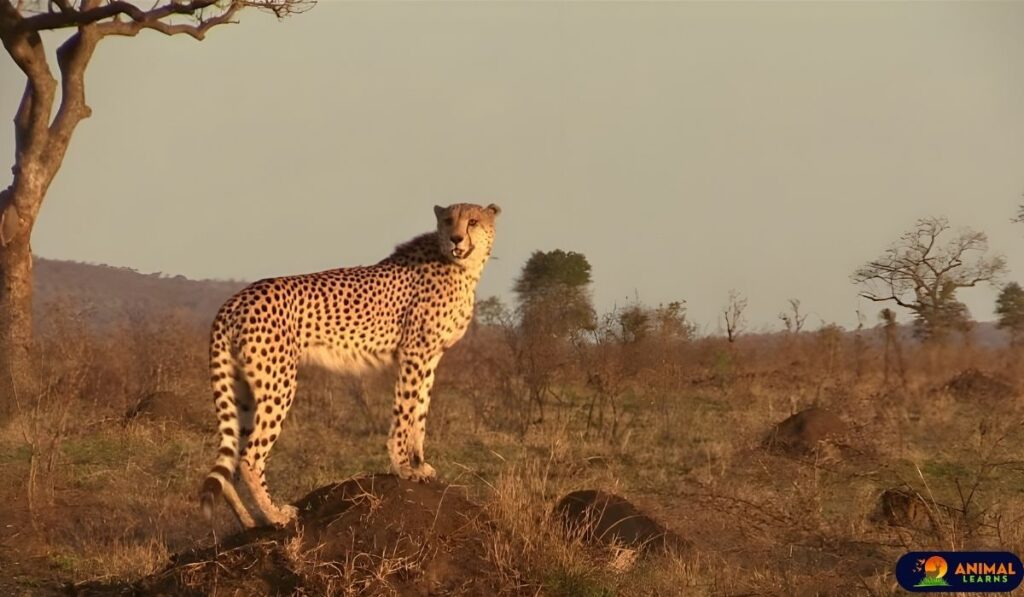
They are amazing animals that live a fascinating and unique life. They usually prefer to be alone, but they also enjoy the company of other big cats during mating season. They are different from other big cats because they like to be awake in the daytime.
They are very sneaky and careful when they hunt, waiting for the right moment to run after their prey. They are very friendly with each other, and they often stay together as a family of a mother and her cubs. They make different sounds to talk to each other, such as purring, growling, and chirping.
These big cats are famous for their speed and skill in hunting, using their fast legs and sharp eyes to catch their food. But they are not very strong, and they sometimes have to give up their food to other animals that want to steal it.
They are wonderful creatures that have adapted to the African savannah, where they use their speed and social bonds to survive in the wild.
Predators
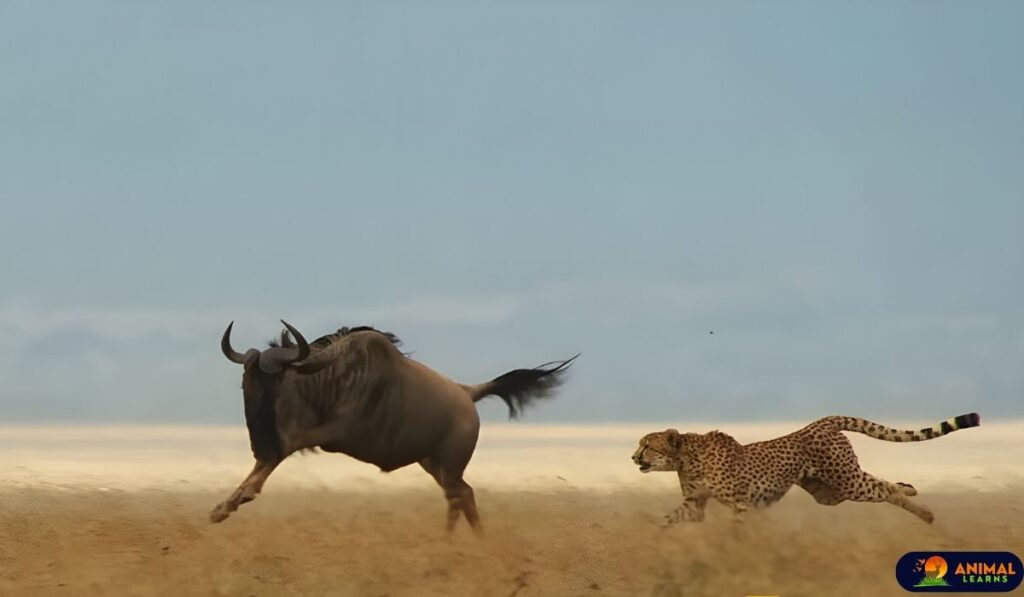
They are powerful hunters, but they also face many dangers in the wild. Their cubs are especially at risk from other animals that want to harm them. Lions, leopards, hyenas, and even eagles can attack cheetah cubs when their mothers are not around.
They also have to deal with losing their homes and being hunted by humans. Sometimes, they get hit by cars or trapped in snares. These problems make it hard for cheetah to survive in the wild. We need to help these amazing big cats and protect their habitats. They are important for the balance of nature and the beauty of the world.
Natural Habitat
They are native to Africa and parts of Asia. They are mostly found in sub-Saharan Africa, where they inhabit savannas, grasslands, and semi-deserts. They prefer open areas with low vegetation and good visibility, where they can spot and chase their prey. They are territorial and mark their home ranges with urine and feces.
However, they face many threats due to habitat loss. Human activities such as agriculture, livestock grazing, mining, and development have reduced and fragmented cheetah habitats, making them more vulnerable to predators, competitors, and poachers.
As a result, cheetah populations have declined dramatically over the years. Today, there are only about 7,100 cheetahs left in the wild.
A Gourmet Diet: What Do Cheetahs Eat?

They are carnivores, meaning they feed on meat. They mainly prey on small to medium-sized ungulates (hoofed animals), such as gazelles, impalas, wildebeests, zebras, and hares. They hunt mostly during the day, using their keen eyesight to locate their prey.
They stalk their prey until they are within 50 to 200 meters (164 to 656 feet), then sprint towards it at full speed. They use their sharp teeth and claws to kill their prey by biting its throat or neck.
They play an important role in the ecosystem by controlling the population of their prey species and preventing overgrazing. However, they also face competition from other predators, such as lions, hyenas, leopards, and wild dogs.
These predators often steal cheetah kills or kill cheetah cubs. They usually avoid confrontation with these predators by fleeing or surrendering their food.
Cheetahs Around the World
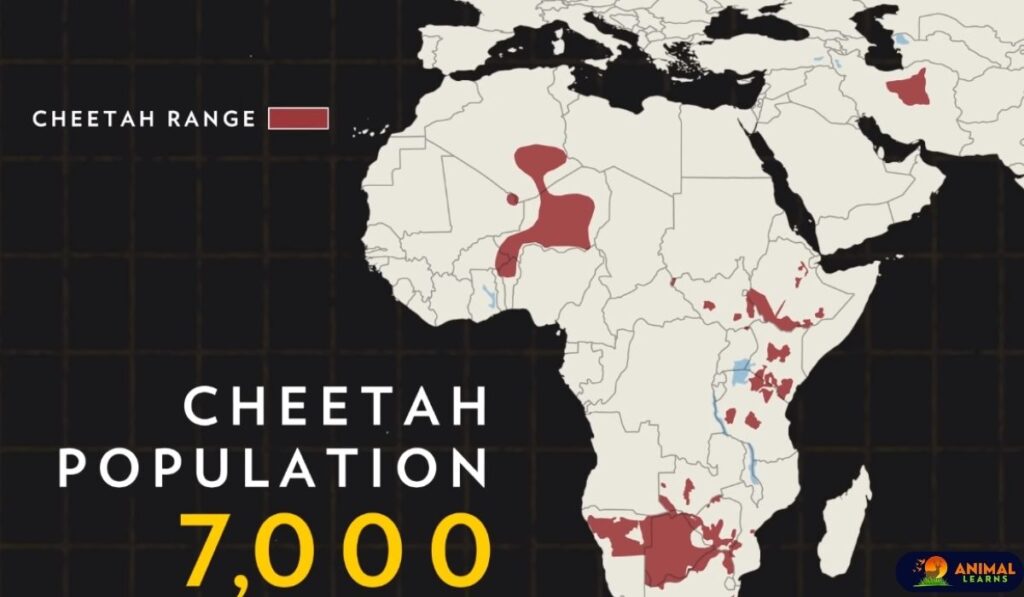
Cheetah populations vary widely across different regions of the world. Some of the most notable areas where big cats can be found are:
- South African cheetah (Acinonyx jubatus jubatus): There are an estimated 4,500 individuals left in this subspecies, which is found in southern Africa.
- East African cheetah (Acinonyx jubatus raineyi):The species is found in eastern and central Africa, with an estimated 2,500 individuals left.
- Northwest African cheetah (Acinonyx jubatus hecki): In Algeria, only about 250 individuals remain in the wild, primarily in Boudechour Wildlife Conservation Area.
- Asiatic cheetah (Acinonyx jubatus venaticus): Only about 50 Asiatic cheetahs remain in a small protected area in central Iran, once widespread across Asia.
- Indian cheetah (Acinonyx jubatus venaticus): Approximately 12 individuals live in the Kuno Palpur National Park, where they were reintroduced to India in 2022.
Cheetahs and Other Creatures

They have a complex relationship with other animals. They interact with different species for various reasons, such as predation, competition, cooperation, or companionship. Some of the most interesting interactions between cheetahs and other creatures are:
- Cheetahs and dogs: There has been a long history of coexistence between cheetahs and dogs. In ancient times, humans domesticated them and hunted with them in Asia and Africa. Several conservationists use dogs to protect wildlife from poachers and farmers. These dogs are also used by livestock owners to deter or chase away potential threats to their prey as guard dogs or livestock dogs.
- Cheetahs and big cats: There are other big cats in the family Felidae, including lions, leopards, and jaguars, but they are more closely related to cougars and lynxes than to these other big cats. A few of the differences between them and other big cats include their slender build, spotted coat, tear marks, non-retractable claws, and purring sound.
- Cheetahs and humans: In human history, cheetahs have been admired and revered for their beauty and speed. They have also been featured in art, literature, mythology, and culture. Humans have also attempted to conserve them as well as raise public awareness of their plight, while on the other hand, humans have exploited and harmed cheetahs for fur, sport, and entertainment. In addition, their habitat has been destroyed and their prey has been reduced.
Survival of the Fastest: Cheetah Adaptations
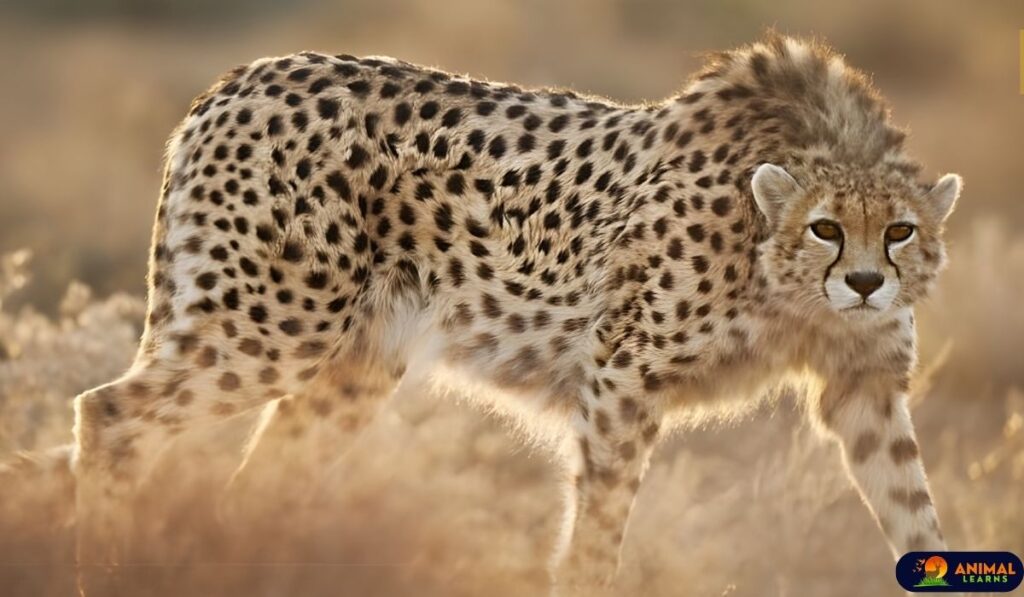
As we have seen, they have many adaptations that enable them to survive in their environment. Some of these adaptations are:
- Their fur: They have a yellowish-brown coat with black spots that help them blend in with their surroundings. Their fur also helps regulate their body temperature by reflecting heat in the day and retaining warmth at night.
- Their eyes: They have excellent eyesight that allows them to spot prey from long distances. They also have binocular vision that gives them depth perception and helps them judge distances when chasing prey.
- Their ears: They have large ears that help them hear well. They can detect low-frequency sounds that indicate the presence of prey or predators. They can also communicate with each other through vocalizations such as chirps, growls, hisses, and purrs.
- Their whiskers: They have long whiskers that help them sense their environment. They use their whiskers to feel objects, air currents, and vibrations. They also use them to express their emotions by moving them forward or backward.
Interesting Facts
- They are the fastest land animals, running up to 70 mph.
- They have black spots on golden fur and black “tear streaks” on their face.
- They can speed up very fast, but not for long.
- They have thin bodies and long legs for speed and agility.
- They hunt during the day and make different sounds to talk.
- They are raised by their mothers and learn how to hunt from them.
- They are in danger of losing their home and being killed by people.
Mating
They have a special way of finding and choosing their mates. Female cheetahs only want to mate every 1 to 2 years for a short time, usually about a week. During this time, they send out special smells to let male cheetahs know they are ready. Male cheetahs travel far and wide to find females who want to mate.
When a male finds a female who is in heat, they start to flirt with each other. They may lick each other, play with each other, and run after each other. After they get along well, they mate. They are very noisy when they mate, and they can make loud and strong sounds.
After mating, the female leaves the male and takes care of the cubs by herself. She is pregnant for about 90 to 95 days, and then she has a litter of usually 3 to 5 cubs. These cubs are born without sight and very weak, and they need their mother to feed them and protect them in their first months. Mating and having babies are very important for them and their survival.
Cheetahs vs. the World: A Look into Their Lives

While they may have a reputation for being solitary hunters, their interactions with other animals and humans are intriguing. In some places, they coexist with other wildlife, including leopards, as they adapt to their surroundings. Some cheetahs even become pets for humans, a practice with both challenges and rewards.
The complex behavior and social dynamics of these cats add depth to their portrayal as apex predators. As conservation efforts strive to protect these endangered species, understanding their unique characteristics, habitat preservation, and the delicate balance of their ecosystem is essential.
Discovering ways to safeguard cheetah populations and their habitats, and finding methods to ensure their coexistence with other animals, particularly in regions like North America, South America, Asia, Europe, and Australia, remains a critical mission in the quest to save these fascinating creatures.
FAQs
How fast can cheetahs run?
They are the fastest land animals, capable of reaching speeds of up to 60 to 70 miles per hour (97 to 113 kilometers per hour) in short bursts.
What is the cheetah’s primary prey?
They primarily prey on small to medium-sized ungulates, such as gazelles and impalas, but they occasionally target smaller mammals like hares or birds.
Are cheetahs endangered?
Yes, They are listed as vulnerable on the International Union for Conservation of Nature (IUCN) Red List of Threatened Species due to habitat loss and human-wildlife conflict.
How long do they live in the wild?
In the wild, they typically have a lifespan of 10 to 12 years, although they may live longer in captivity.
Do big cats live in groups like lions or are they solitary animals?
They are mostly solitary animals, with males sometimes forming small groups called coalitions, typically consisting of brothers from the same litter. Females are usually solitary, except when raising cubs.







